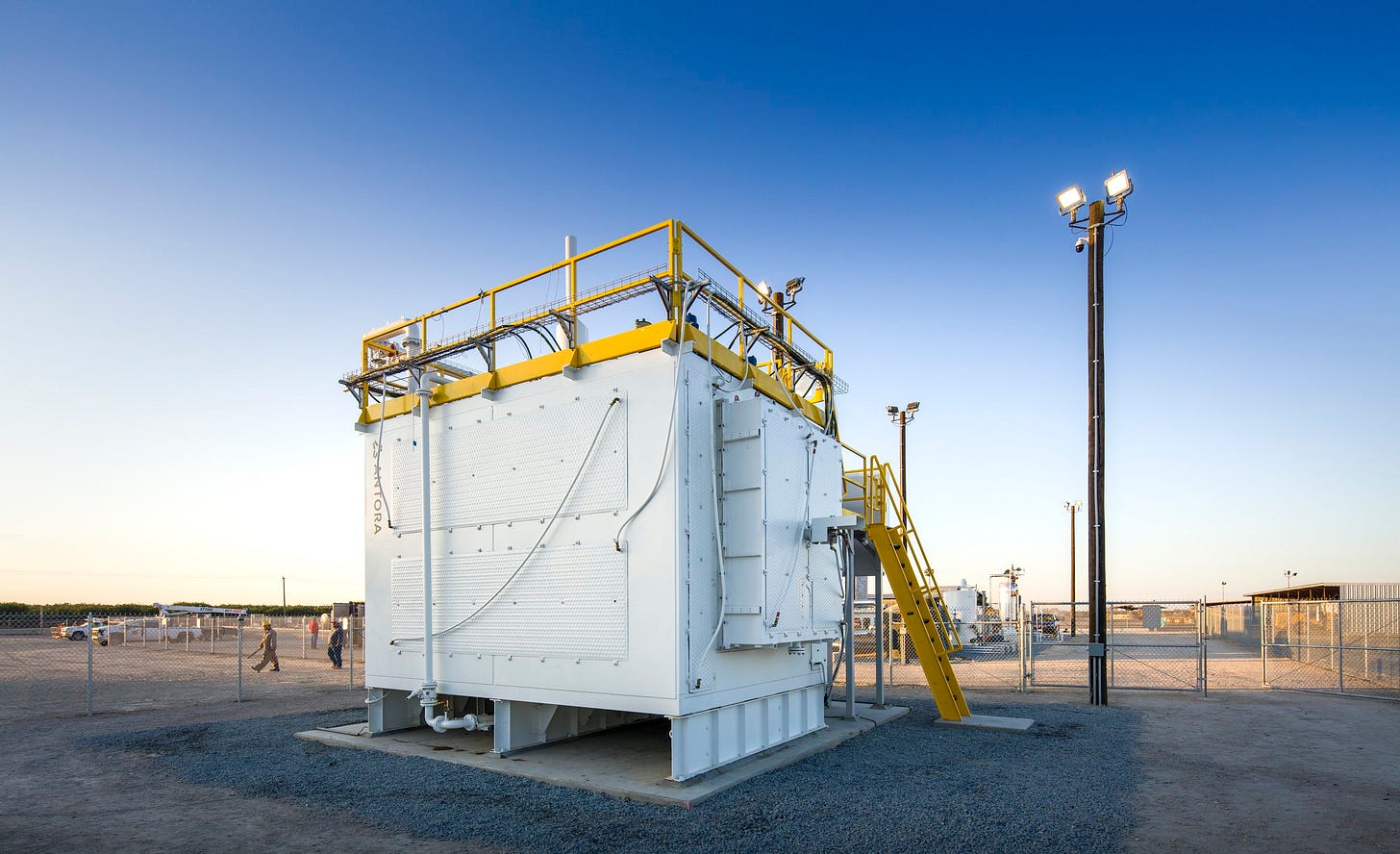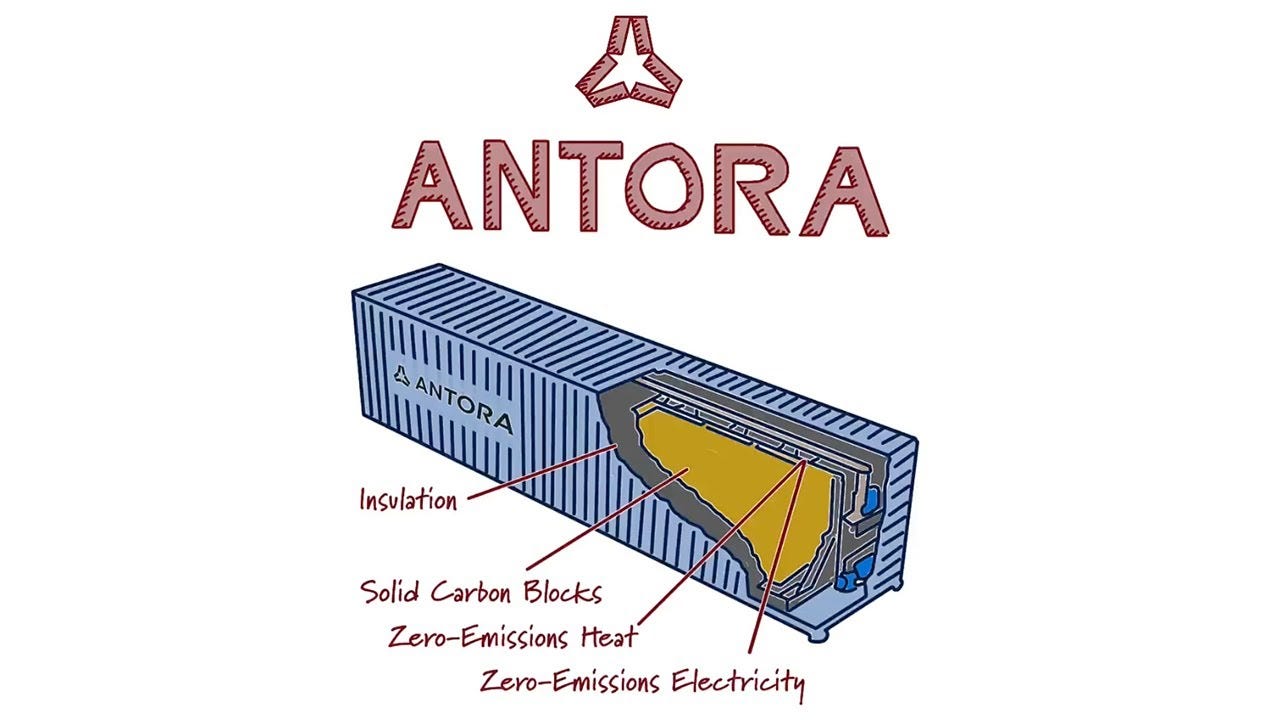#42 Antora
Transforming industry with zero-carbon thermal batteries
Read time: 5 minutes
Hi, I’m Javi Gascón.
This is Climate Tech Distillery, a newsletter where I talk about one specific climate tech company every week.
Subscribe for free to receive my weekly articles in your inbox.
Today we’ll distill a company that’s creating zero-emissions industrial heat & power with revolutionary thermal energy storage: Antora
Want to sponsor Climate Tech Distillery? Here’s all the info.
What Problem Does Antora Tackle❓
They deal with the problem of the intermittent nature of renewable energy and its integration into heavy industry, which can be broken down into several key issues:
1. Intermittency of Renewable Energy: Renewable energy sources like wind and solar are unpredictable, leading to periods of overproduction and underproduction. This intermittency makes it challenging to rely on these sources for continuous energy supply.
2. Economic Impact on Renewable Investments: The saturation of renewable energy in the grid causes the value of electricity to plummet during peak production times, limiting investments in renewable energy projects, especially in areas with high renewable potential.
3. High Energy Demand in Industry: Industrial processes from many sectors require high temperatures and a continuous energy supply, which currently rely heavily on fossil fuels. This accounts for about 20% of global energy demand.
4. Environmental Impact: The reliance on fossil fuels in industry contributes significantly to global emissions, with heavy industry accounting for around 30% of global emissions.
Product / Service 📦
Antora has created a thermal battery system that converts low-cost, intermittent renewable electricity into reliable industrial heat and power.
The renewable electricity heats blocks of solid carbon to extremely high temperatures (up to 2,400°C) in insulated modules, storing energy as heat. Then, the stored heat can either be delivered directly to industrial processes or converted back into electricity.
Why is this so awesome?
Reliable and Continuous Energy: The thermal battery offers multi-day thermal storage, ensuring always-on heat and power for industrial operations where downtime is not an option.
Cost-Effective: It charges with surplus clean electricity, delivering cost-effective energy at a predictable price, which can significantly reduce energy costs for industrial companies.
Scalable and Modular: The factory-built, modular design allows for rapid deployment and seamless integration, serving loads from megawatts to gigawatts, and minimizing site disruption.
Safe and Durable: The system uses solid carbon, a safe and stable material, with a decades-long lifespan and no risk of thermal runaway.
They currently only sell one type of system but they’re developing others that can deliver more heat and electricity. The current one reaches 400°C, which makes up more than half of industrial heat used.
Market 🌐
Antora operates in the LDES (long duration energy storage) market. It’s currently valued at USD 39.41 billion and forecasted to grow 25% per year until 2031! That massive growth is due to 3 main reasons:
Growing demand for grid stability and energy storage solutions.
Increasing renewable energy integration.
Political and consumer support.
That demand increase is even more significant in the industrial sector, Antora’s target.
Other Key Players
Rondo Energy 🇺🇸: Uses a heat battery to store renewable-energy heat in bricks, providing a low-cost, zero-emission heat solution for industrial processes.
Malta 🇺🇸: Develops a thermal energy storage system that can gather and store energy from any source, dispatching it as electricity on demand for extended periods.
MGA Thermal 🇦🇺: Specializes in thermal energy storage using graphite blocks, offering a solution for storing thermal energy that can be used for heating and cooling applications.
Founding Story 🦄
Antora was founded in 2018 by Andrew Ponec, Justin Briggs, and David Bierman.
Andrew previously founded a solar energy company called Dragonfly Systems. There he realized how fast renewable costs were dropping and knew that all of this very cheap, clean electricity had to be used in new ways to other climate challenges.
Justin, a PhD in applied physics and thermophotovoltaic (TPV) technology researcher, and Andrew met at Stanford. They studied all sorts of climate applications for what to do with this massive amount of cheap renewable electricity. They realized Long-Duration Energy Storage (LDES) had the biggest gap.
They then met David, PhD in mechanical engineering from MIT, specializing in solar thermal energy systems. All of them were really excited about LDES and given their backgrounds started working on an approach to LDES with thermal batteries.
The mission was clear: Store energy as heat in inexpensive raw materials and convert it back to electricity using TPV technology, aiming to decarbonize heavy industry and the entire electricity grid.
The Activate fellowship was key to get them going and now they have raised over $230 million.
Top Impact Stats 📈
Their battery system has the potential to cut over 50% of industrial emissions.
The 20% of global energy demand that goes to industry can be decarbonized with their systems.
Their zero-emissions batteries are safer, longer-lasting, more efficient, and cheaper than anything available today.
Whenever you’re ready, there are 2 ways I can help you:
Scale and optimize your climate business: I build low-code automation systems for climate companies so they can free up time to scale their revenues and their climate impact.
Give visibility to your climate company: Get your company in front of an audience of thousands of climate players and enthusiasts by sponsoring newsletter issues and LinkedIn posts.
Thanks for reading today’s issue! If you liked it feel free to hit the ❤️ button and share it with someone who might like it too. See you on Jan 11th, enjoy the holidays :)









